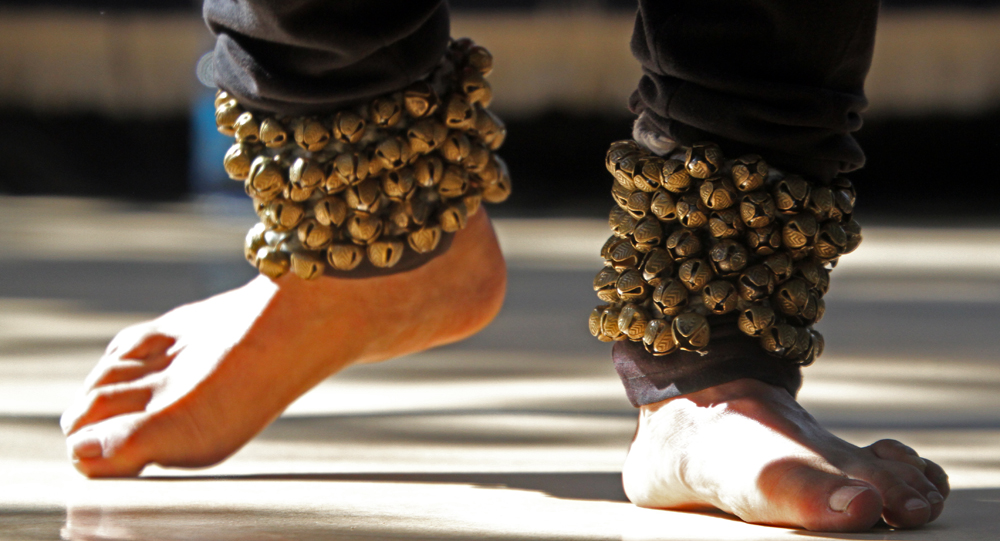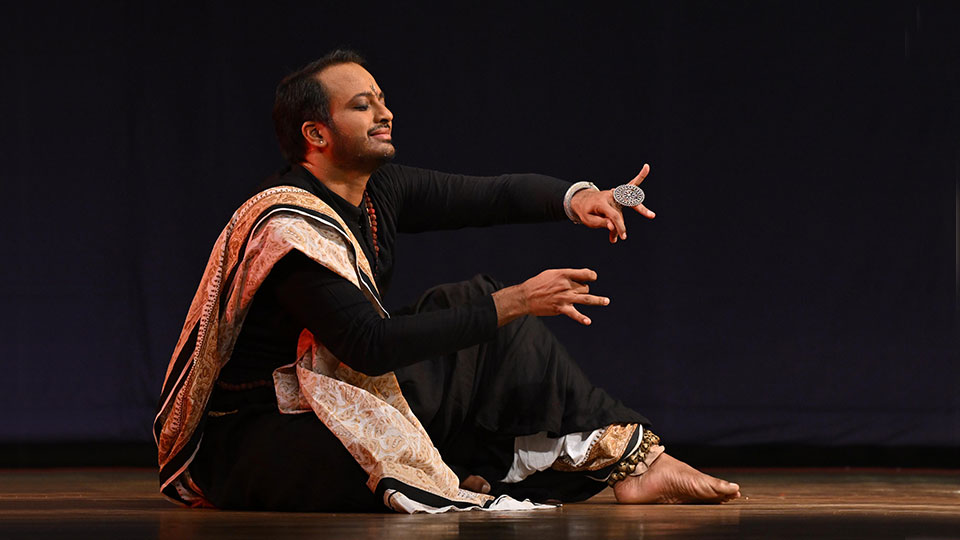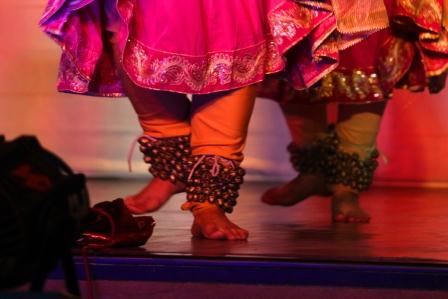Indian Classical dance form is synonymous with Ghungrus. Technically a type of instrument, Ghungrus or the ankle bells are very much a ‘motif’ in the context of Indian culture in general and Indian Dance in particular. Bells are the symbol of bliss and auspicious celebrations. Even bells are added to every adornment, may it be anklets, bangles or a waist chain to give them the resonance. The sound of bells denotes beauty. For a classical dancer, Ghungrus are not just an accessory but they are the symbol of divine connection he or she has with the “Anahad naad”, the divine universal sound.
Ghungrus as an instrument: The dance bells are a series of tiny bells either tied with a peculiar knot in a string or stitched together in rows on a belt, and the dancer ties the belt or string to his/her ankle. They are either made of brass or bronze.
Technically, ghungrus are a percussion instrument. They are Ghan-vadya implying non-membranous percussive Instruments having solid resonators. This the oldest class of Instruments which also includes Manjira, ghatam, Kartal etc.
However, in Classical dance, ghungrus are never a mere accompanying instrument but are unconditionally part and parcel of the leading performance. Ghungrus are rarely isolated as a separate accompanying instrument but are innate part and symbol of dance alone.
The tap dance is also a dance form with major emphasis on footwork. This form uses the tap-shoes as a form of percussion. Same is the case with other forms like Flamenco.
Ghungrus enhance the footwork. The sound of Ghungrus is the language of footwork. As the creative thought of a poet reaches the reader’s heart through the medium of words, so is the role of ghungrus, carrying the intricacies of footwork to the audience.
Ghungrus enhance the sound of footwork. Especially in Kathak, where the ‘footwork’ or ‘Tatkar’ is an independent item, the ghungrus have a vital function. Kathak is a blend of dance with the upper body and percussion with the feet. Kathak footwork includes complexity and variety and dancer uses a variety of footwork such as stamping with a flat foot, with the heel, with a side of the foot, sometimes just sliding the foot or even the toe. These varieties are perceptible only with the help of Ghungrus.
Accompanying instruments may enhance the dance too but they are as inevitable as the ghungrus. Dance is incomplete without ghungrus.
 When a classical dancer performs on a ‘song’ played live by accompanists, the ghungrus replicate and patterns themselves with the rhythm of the song and thus here, ghungrus play the role of that string the weaves together the dancer, the orchestration and the spectator. Even when the dancer is presenting some exclusive poignant piece by mere sitting in one position (‘Baith ke bhaav’ as it is called in Kathak) subtle foot sound at ‘sam’ elevates the expressions.
When a classical dancer performs on a ‘song’ played live by accompanists, the ghungrus replicate and patterns themselves with the rhythm of the song and thus here, ghungrus play the role of that string the weaves together the dancer, the orchestration and the spectator. Even when the dancer is presenting some exclusive poignant piece by mere sitting in one position (‘Baith ke bhaav’ as it is called in Kathak) subtle foot sound at ‘sam’ elevates the expressions.
The rhythmic sound emanating from the tiny bells elates and gratifies the sense of the audience. The dance bells leave a lasting sound impression in the minds of the audience heightens the impact of the performance.
Abhinay Darpan describes in detail various aspects of ghungrus.
सुस्वराश्च सुरूपाश्च सूक्ष्मा नक्षत्रदेवताः।
किंकिण्य: कांस्यरचिताः एकैकाङ्गुलिकान्तरम्॥
बध्नियान् नीलसूत्रेण ग्रन्थिभिश्च दृढं पुन:।
शतद्वयं शतं वापि पद्योर्नात्याकारिणि॥
Kinkini or the ghungrus should be made up of brass, should resonate sweetly. Their size should not be too small or too big. They should be of a crescent shape and with four petals (parts). All the bells should sound harmonious so that they will enhance the footwork. Abhinaydarpan mentions the required number of ghungru to be hundred to two hundred. The text also mentions stringing the ghungrus in a blue colour string. Ghungrus tied in a string appears to be an older form of ghungru as the same is mentioned in the scriptures and a similar style is observed in the various sculptures across India including Sanchi, Kausambi, Bodhgaya, Dilwara.
A dancer interprets a bandish or a bol through his body movements, glances, neck movements and footwork. Ghungrus makes this interpretation of a bol complete. Some peculiar phrases in Kathak such as kran, tharri, thun-thun are just not possible to perform without ghungrus.
A well-trained dancer may be able to replicate the most complex composition with the mere sound of foot but ghungrus turn the craftsmanship into sweet-sounding and pleasing art.
A Kathak dancer presents a unique item of Gatbhav similar to miming, where the dancer enacts a complete story through dance alone without using any words or poetry. Ghungrus play a crucial role here since the dancer uses them to depict various bhavs, be it showing heavy rains and thunder or delicate gait of a peacock, dancer uses the sound of ghungrus skillfully.
Even the literature of dance is full of various mentions of ghungrus. Ghungrus and anklets are the inevitable part of Shringara of Nayika. Nayika uses the sound of her anklets to attract the attention of her beloved and the Abhisarika removes her anklets while secretly going to meet her beloved. The words ‘chum chan na na’ implying sounds of ghungru are frequently used in the compositions.
The ghungrus are equally important in the dance training. The sound of ghungru enables a student to merge his movements and footwork with the rhythm of the instrument or music. Guru hands over the ghungrus to the Shishya bestowing upon him with his knowledge and making him responsible and committed to the art. Ghungrus are thus a symbol of the bonding between Guru and Shishya, the symbol of imparting art from the Guru and the symbol of the devotion of the Shishya.
Ghungrus are thus not a mere adjunct but they are the soul of dance. For a dancer, they are far more than an accessory but are the form of her dedication towards her dance form. This is the reason, the dancer worships the ghungrus at the feet of Lord Nataraj and at the feet of Guru and take great care and love to keep up their sanctity.










